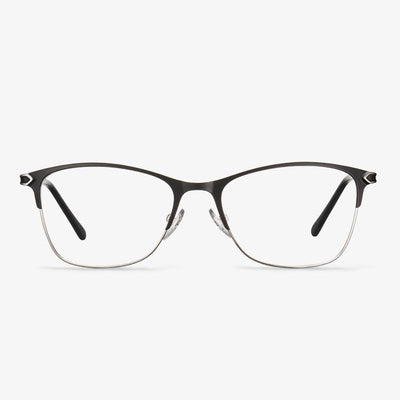How to Choose Reading Glasses?
In this section, we will show you some tips for choosing reading glasses.
Find the right power. When choosing reading glasses, finding the right power would be the most important thing. All reading glasses will have signs or stickers indicating their power. In most cases, they will range from +1 to +4 diopter, in increments of +0.25. So, when choosing reading glasses, try the lowest power first.
Test-drive the glasses. If you have brought reading material with you, try reading it at a comfortable length. If you hold the material too far out to be able to read it, you should increase the power. Keep testing the differences powers until can read clearly at the distance that’s more comfortable for you.
Choose big frames the first time. When choosing reading glasses, you can choose the big frames for the first time. You may need larger glasses frames or lenses to really get the sweet spot of where the prescription is.
And if you have never worn glasses for eye conditions such as nearsightedness, farsightedness or astigmatism, it is likely you will be able to see well with non-prescription reading glasses. So, you can buy these non-prescription reading glasses.
Common Problems with Varifocal Glasses
In this section, we will list some common problems with varifocal glasses. The most common problem with varifocal glasses is people being unable to focus on what they need to. Losing focus often leads to some discomforts such as headaches or dizziness when performing tasks that require quick changes in near and middle-distance focus.
Besides, some people also experience a sort of swimming feeling when they are walking. It may be caused by being very aware of the distortions in your peripheral vision as well as the reading portion at the lower part of the lenses.
So, how to use varifocal glasses? The best way is to keep yourself from looking downward as you walk. You may also experience soft focus at the edges of the lenses and need to move your head more to see near objects better.
What should drivers notice when wearing polarized glasses?
Many drivers like to wear polarized lenses. Indeed, the polarized lens can reduce strong light, eliminate glare, so that the line of sight is natural and soft, but the polarized lens is more suitable for fishing, skiing, and other large areas of the reflective environment. Drivers sometimes have to face the tunnel and another dark scene, the polarized lens is easy to make people suddenly feel dark at the moment. In addition, polarized lenses can make LCD screens and LED traffic lights dim. Therefore, when choosing polarizers, it is best to choose good quality optics, and when going through the tunnel, it is best to take off your glasses ahead of time and blink a lot. Before wearing the driver polarizing lens, try it on and observe whether the polarizing film of the lens is smooth. If the polarizing film is uneven, there will be inflow in the imaging, which may lead to visual fatigue and migraine.
What Are the Disadvantages of High-Index Lenses?
This section will show high index lenses disadvantages.
- High index lenses are made from a chemical synthetic blend that’s created through a special manufacturing process. So, high index lenses are expensive than regular lenses. In fact, the price may be more than double that of the traditional counterparts.
- High index lenses can be more brittle than their traditional counterparts and may also be more prone to scrapes and scratches. This can impact their overall durability.
- High index lenses are more reflective than regular lenses, which can make them less effective for brightly lit work environments, outdoor use and nighttime driving on busy highways.
- High index lenses have greater potential for distortion, particularly in your peripheral vision because the high index lenses have a higher Abbe value than prescriptions made from standard plastic or glass.
Are children optometry matched with glasses the same as adults?
The optometry of children is one of the main works of optometry. Compared with adult optometry and glasses, children's optometry and glasses have both commonness and particularity. It is an area at the intersection of pediatric ophthalmology, pediatric optometry, and optometry. It requires the operator not only to have the knowledge of ophthalmology but to have the basis of children's ophthalmology and children's optometry. And they should be an optometry expert. Dealing with children's refractive problems is as much an art as a technique.
Where to Buy Anti Glare Glasses?
From the above part, you have learned the benefits of the anti reflective coating glasses. So, you may wonder where to buy them. To do that, you can buy them from the local optical store and online. If you want to buy anti reflective glasses online, you can try Koalaeye Optical, which provides all kinds of glasses, sunglasses, and frames. In addition, Koalaeye glasses are stylish and come at a cheap price. So, if you need to a pair of anti glare coating glasses, try Koalaeye glasses.
Compared with single vision glasses, bifocals are multi-focal glasses.
Compared with single vision glasses, bifocal glasses, trifocal glasses belong to multi-focus glasses, and the types of trifocal glasses are diverse. When choosing the optical properties of a trifocal lens, it can be thought that the lens is made up of three different lenses: the main lens, the distal optic regions, two appendages. One for the distance and one for the proximal area.











































